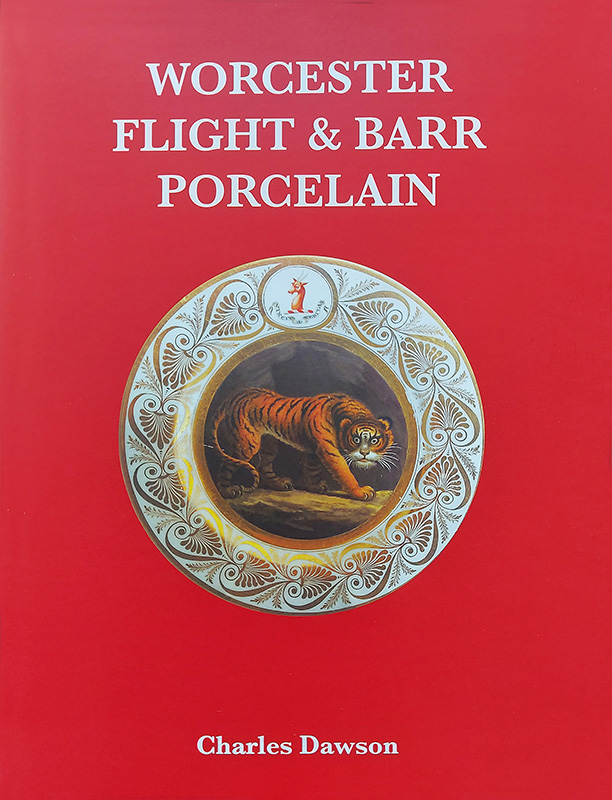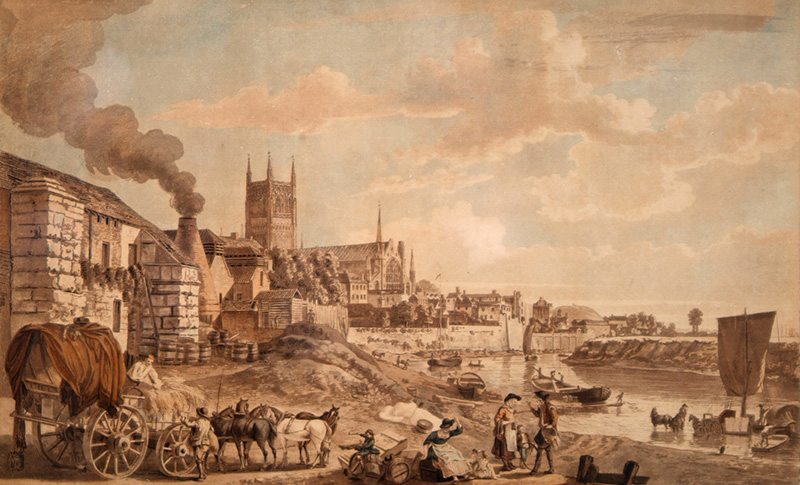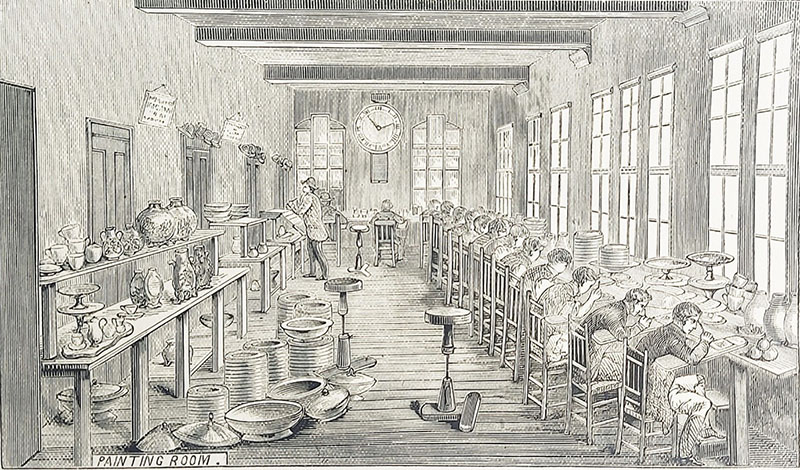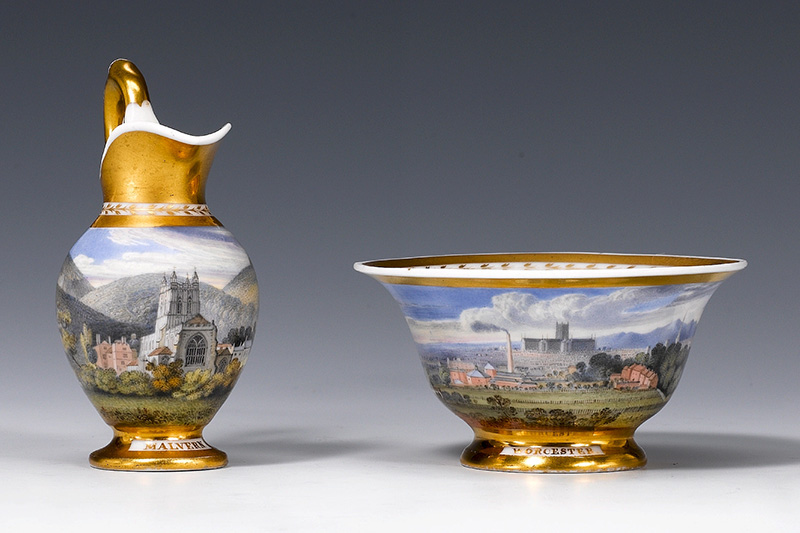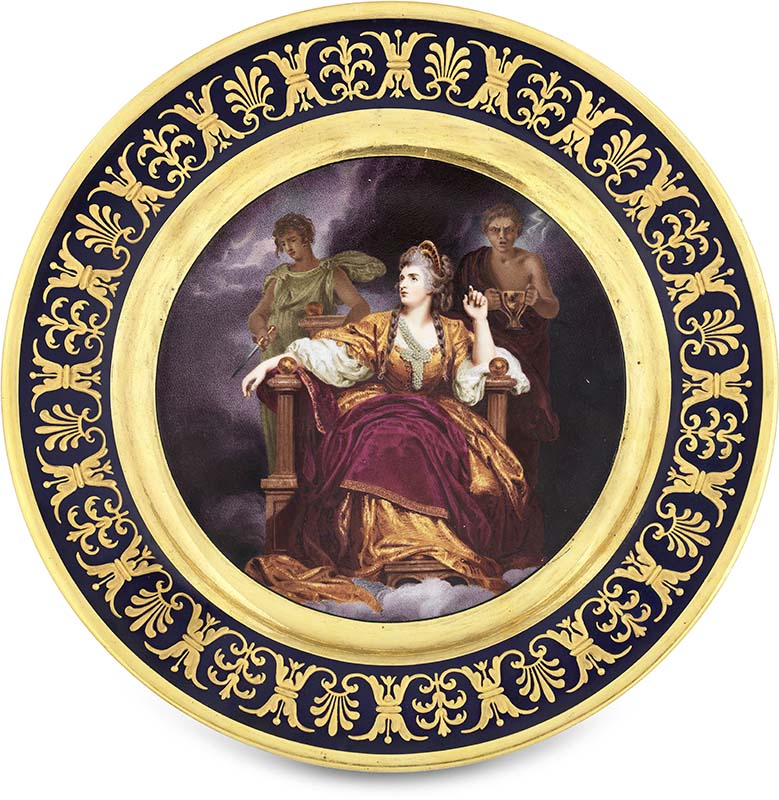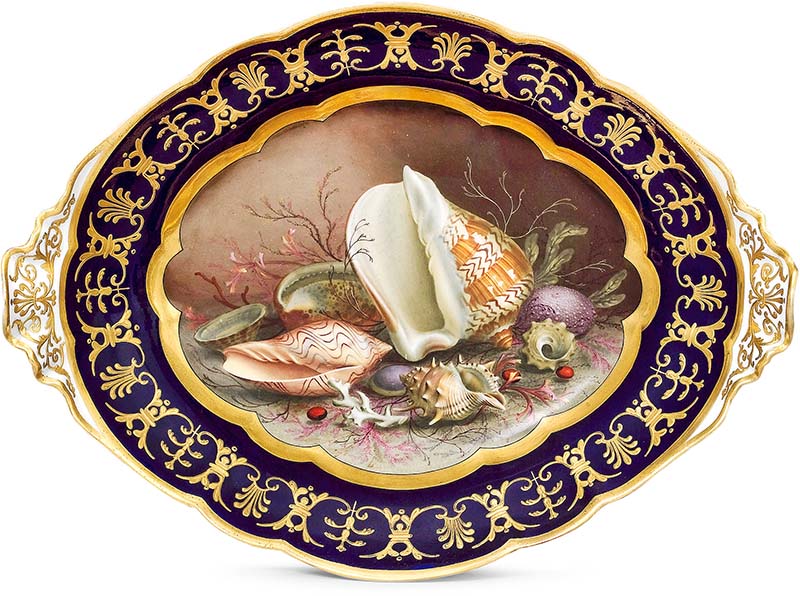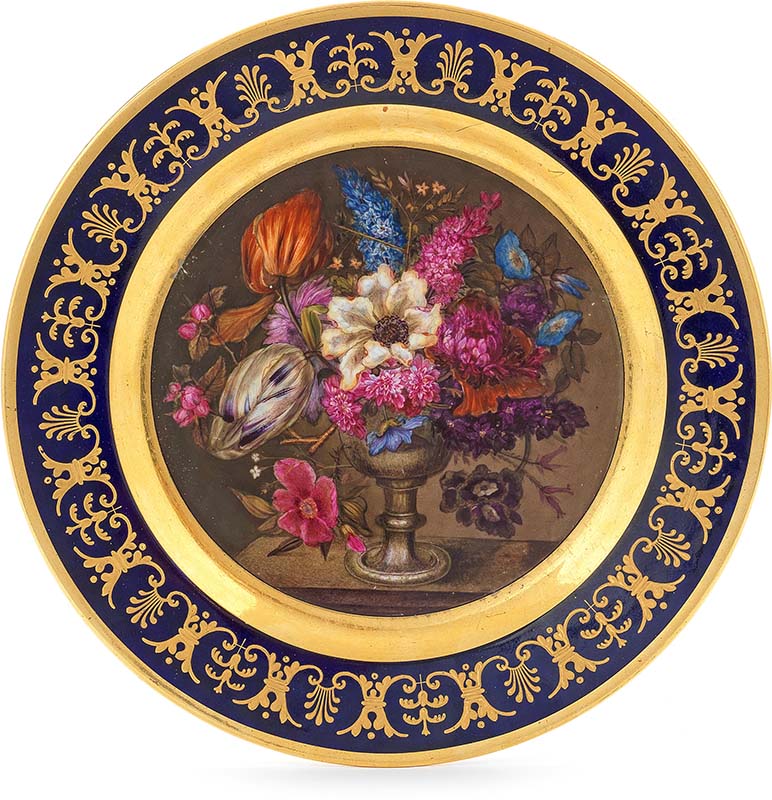The Finest Regency Porcelain Painter: Thomas Baxter in Worcester
by Charles Dawson
There is no greater name in the history of English Regency porcelain painters than that of Thomas Baxter (figure 1). His whole life was given to the art of porcelain painting, and his work at the Worcester Flight & Barr factory (figure 2), the subject of a new book, is among the choicest of the era. The factory’s wares were purchased by the British and foreign aristocracy and the professional classes and are now revered by collectors around the world. The rich colors, fine molding, superb painting, and beautiful gilding demonstrate the superior quality.
Baxter was born on February 18, 1782, in London. In 1800, he enrolled as a student at the Royal Academy and received drawing lessons from Henry Fuseli, Professor of Painting.1
After the Academy, Baxter joined his father’s independent painting establishment at 1 Goldsmith Street in London. His father purchased plain white porcelain blanks, mostly from Coalport and China, for the purpose of painting, gilding, and selling it. This enameling studio was the leading establishment of its day, and the quality of painting was similar to that achieved by contemporary Continental factories.
In 1802, the 20-year-old Baxter was invited to Merton, Horatio Nelson’s country house, to make sketches of the surrounding countryside, Nelson’s daughter Horatia, and their guests. Baxter made several visits to the house as Emma Hamilton’s guest while Nelson was at sea. From 1802 until 1821, he exhibited at the Royal Academy, showing a total of 16 works of art.2
Baxter was married to Ann Roberts of Middlesex at St. Brides Church on Fleet Street in London on May 8, 1808. They had a son and four daughters. Due to ill health, Baxter left London for Worcester in 1814 to paint for Flight & Barr, specializing in figural subjects as well as painting portraits and miniatures. He established a school of art at his home from 1814 to 1816. His pupils later distinguished themselves as decorators at Flight & Barr.
The Painting Room in the factory was illustrated in 1810 (figure 3) and described in the personal reminiscences of painter Solomon Cole, as recorded by William Chaffers in Marks and Monograms on Pottery and Porcelain (1891):3
The painting room was a 100-foot long. There were several peculiarities connected with the manufactory of Messrs. Flight Barr & Barr, one of which was paying people by time and not the piece. This plan was wholly confined to them, and they adopted it to secure the greatest possible degree of excellence in all they produced. … Their orders came from the nobility and most of the distinguished families of the United Kingdom; they kept no traveler, nor did they transact business with retail houses.
… Frequently, on Messrs. Martin and George Barr going round the painting-room, which was their custom twice a day, they would say to the painters engaged upon the richest services, ‘We want you to consider this as jewelry – we wish you to take all possible pains.’
Baxter’s relationship with Flight & Barr became strained. The artist was bothered by assignments to paint less important pieces than his skills warranted. He left Worcester in 1816 to join Mr. Dillwyn’s Cambrian factory in Swansea, where he remained for three years on a freelance basis. He advertised in the Cambrian newspaper as a drawing master, miniaturist, and portrait painter. Without enough work and needing to support his family, Baxter returned to Worcester in 1819. He was again engaged at the Flight & Barr factory for a short time. More difficulties arose with the management, and he subsequently moved on to the Worcester Chamberlain factory in July 1819.
In a letter to Benjamin Haydon,4 a British painter who had trained at the Royal Academy with him, Baxter writes:
Five years banishment from all that is great [London] has rather increased, if possible, my love of the arts. My health of body is very much improved for my removal [from London]. I cannot say much for my mind as I am employed here [Chamberlain] on little things the ‘littler the prettier’ the dear little things and the dearer they are made the better.
What were these “dear little things” that Baxter mentions in this letter? Worcester with its Cathedral and Malvern with its Spa were hotspots in the early 19th century. As such, visitors needed souvenirs to take home. What better memento than a small piece of highly decorated Worcester porcelain? Baxter was not keen on decorating these delightful small items (figure 4) because they did not utilize his extraordinary painting skills. Painting such tiny wares, however, did require considerable skill.
Baxter loved the London theater and sketched during the shows. His figures are captivating, and he missed the theater greatly when he moved to Worcester in 1814. One of the earliest extant objects painted by Baxter at Flight & Barr is decorated with a portrait of the famous actress Sarah Siddons, who is depicted as Melpomene, the Muse of Tragedy (figure 5). She is seated on a throne with a dagger and cup held by figures of Terror and Pity standing behind her. Siddons was the leading tragic actress of the time, most famous for her Lady Macbeth. Baxter painted two of these plates in 1814.5
Baxter’s plaque of the Bard (figure 6) has a quotation from Thomas Gray in the painter’s distinctive hand: “Love his beard and hoary hair stream’d like a meteor to the troubled air.” The poem titled “The Bard” was published in 1757. The plaque depicts the last-surviving Welsh Bard cursing King Edward I, before throwing himself in the River Conway.
While exiled in Worcester, Thomas Baxter felt separated from London and all it represented. He retained fond memories of the beautiful Emma Hamilton. Baxter depicted her on a pair of vases (figure 7) with portraits of “Saint Cecilia” and “Sappho” after Richard Westall’s paintings of Emma Hamilton. Baxter had made many sketches of her during his visits to the Hamilton home in Merton in 1802–04.
Baxter’s painting of shells (figure 8) and flowers is highly individual, and of exceptional quality. The former are often depicted in groups on sand with sky beyond or on a marble table. A small number are titled “Shells from Nature,” written in his distinctive hand. The artist had his own collection of seashells to inspire these unique compositions. One exquisite example of Baxter’s floral painting is an 1812–14 plate (figure 9) that shows a goblet on a stone shelf overflowing with tulips, buddleia, and morning glory.
Thomas Baxter died in Worcester on April 18, 1821, aged 39, from ill health and was buried in the church of St. Michael Bedwardine on April 22, 1821. This church was demolished in 1843, and sadly his grave does not exist, but he left behind a wonderful legacy of painted porcelain and pictures demonstrating his artistic genius.
- Baxter’s 1810 book, An Illustration of Egyptian, Grecian and Roman Costume, was dedicated to Henry Fuseli.
- Forty of Baxter’s sketches can be viewed on the Royal Academy website at royalacademy.org.uk.
- William Chaffers, Marks and Monograms on Pottery and Porcelain, 7th ed, (London: Reeves and Turner, 1891).
- Thomas Baxter to Benjamin Haydon, July 18, 1819.
- The first plate was sold to the Marquis of Stafford for 50 guineas and was auctioned by Bonhams in 2019 for £20,000. The second example was in the Collection of Mr. H Rokeby Price. The Rokeby Price plate was sold from the Wentworth Wass Collection by Phillips on June 18, 1980, (lot 173) and is now in The Museum of Royal Worcester.
Charles Dawson, FRSA, is the former President of the English Ceramic Circle. Further information about Thomas Baxter and other Flight & Barr painters are in his new book Worcester Flight & Barr Porcelain available at www.flightandbarr.com.
A print version of this article was published in The Magazine of the Decorative Arts Trust, one of our most popular member benefits. Join today!

